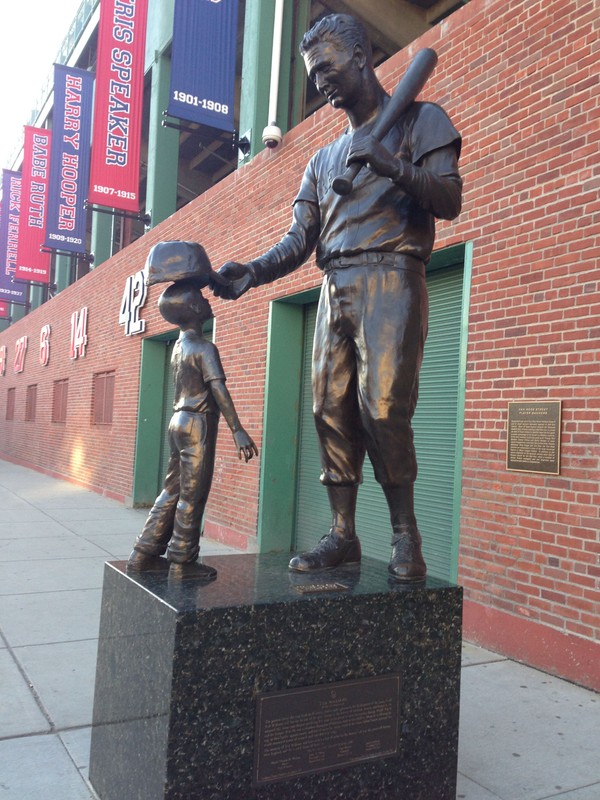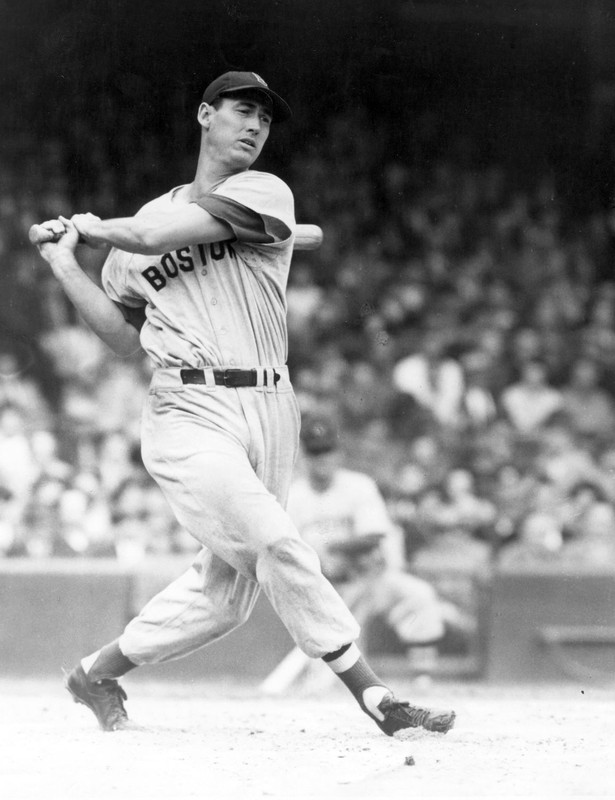Ted Williams Statue
Introduction
Text-to-speech Audio
This statue commemorates Boston Red Sox Hall-of-Fame slugger Ted Williams (1918-2002). A native of San Diego, he spent his entire major league career with the Red Sox. During that time, Williams won two American League Triple Crowns and six batting titles. He remains to this day the last major league player to hit .400 or above in a season. More than simply a great professional baseball player, Williams served his country in the Second World War and the Korean War. He also made frequent visits to local hospitals to visit ailing children during his playing career. Shortly after Williams’ death, Boston Mayor Thomas Menino suggested that a statue of the Red Sox great be erected in the city. A. Hank Evanish, who received his flight training under Williams many decades earlier, agreed to bankroll the project. Designed by sculptor Franc Talarico, the eight-and-a-half-foot-tall bronze statue depicts Williams standing, holding a baseball bat on his left shoulder. He gently places his baseball hat on the head of a bronze cancer-stricken boy, with whom he shares a four-foot-tall granite pedestal. Talarico drew inspiration for the statue of the boy from Einar “Jimmy” Gustafson, the sickly twelve-year-old who in 1948 helped kick start the Jimmy Fund, which still raises money for the Dana-Farber Cancer Institute. Dedicated in April 2004, the bronze pair stands outside Gate B of Boston’s historic Fenway Park.
Images
Ted Williams Statue outside Fenway Park's Gate B

Ted Williams (1918-2002)

Williams in the cockpit of his fighter plane

Backstory and Context
Text-to-speech Audio
Theodore Samuel Williams was born on August 30, 1918 in San Diego, California. His father, Samuel Stuart Williams, was a New York-born photographer and alcoholic, while his mother, May Venzor, was a Mexican-American evangelist who worked with the Salvation Army, often preaching on street corners late into the night or traveling to Mexico to save souls. As a result of his father’s drinking problem and his mother’s zealous devotion to her religious faith, Williams and his younger brother often suffered from neglect. Taught to throw a baseball by his maternal uncle, he played in neighborhood sandlots before starring on the baseball team at the city’s Herbert Hoover High School. In the summer of 1936, Williams, at the age of seventeen and still in high school, signed with the San Diego Padres, then a minor league team competing in the Pacific Coast League. He ultimately spent three seasons in the minor leagues, playing two seasons with his hometown Padres and one with the Minneapolis Millers, the top-level affiliate of the Boston Red Sox.
In 1939, Williams received a call-up from the Red Sox, beginning what would become a lengthy major league career. During that span, he led the American League in on-base percentage twelve times and homeruns four times. The slugger also won six American League batting titles. In 1941, Williams finished his third season with the Red Sox with a batting average of .406. He remains to this day the last major league player to hit .400 or above in a season. The following year, Williams won his first American League Triple Crown with a .356 batting average, thirty-six homeruns, and 137 RBIs. In 1946, he led the Red Sox to a World Series berth and captured the American League’s Most Valuable Player Award. The next season, he won his second American League Triple Crown. In 1949, Williams won his second American League Most Valuable Player Award and nearly captured another Triple Crown. Following the 1960 season, he ended his major league playing career, but not before hitting a homerun on his final at bat. Williams finished with a .344 batting average, 521 homeruns, and 1,839 RBIs. In 1966, he was elected to the National Baseball Hall of Fame in his first year of eligibility. Williams returned to Major League Baseball in 1969 as the manager of the Washington Senators (who soon after became the Texas Rangers), earning American League Manager of the Year honors in his first season. Following the 1972 season, he retired from coaching. Williams passed away on July 5, 2002.
Williams, however, was much more than simply a great professional baseball player. He was also an American patriot and humanitarian. In 1942, with the United States at war, Williams enlisted in the U.S. Navy, eventually becoming a flight instructor. He went on active duty that November and subsequently missed the 1943, 1944, and 1945 big league seasons. Early in the 1952 season, military duty called once again. Flying combat missions over Korea, Williams missed nearly the all of the 1952 and 1953 seasons. In addition to serving his country in the military, he made frequent visits to local hospitals to visit ailing children during his playing career.
Shortly after Williams’ death, Boston Mayor Thomas Menino suggested that a statue of the Red Sox great be erected in the city. A. Hank Evanish, who received his flight training under Williams many decades earlier, agreed to bankroll the project. Designed by sculptor Franc Talarico, the eight-and-a-half-foot-tall bronze statue depicts Williams standing, holding a baseball bat on his left shoulder. He gently places his baseball hat on the head of a bronze cancer-stricken boy, with whom he shares a four-foot-tall granite pedestal. Talarico drew inspiration for the statue of the boy from Einar “Jimmy” Gustafson, the sickly twelve-year-old who in 1948 helped kick start the Jimmy Fund, which still raises money for the Dana-Farber Cancer Institute. Dedicated in April 2004, the bronze pair stands outside Gate B of Boston’s historic Fenway Park.
Cite This Entry
Admin, Clio, David Havens, and Francis Curran. "Ted Williams Statue." Clio: Your Guide to History. June 18, 2021. Accessed April 2, 2025. https://theclio.com/tour/337/10
Sources
"Red Sox unveil Williams Statue." mlb.com. Major League Baseball. Web. 17 June 2021 <https://www.mlb.com/content/printer_friendly/bos/y2004/m04/d16/c718473.jsp>.
"Ted Williams." baseballhall.org. National Baseball Hall of Fame. Web. 17 June 2021 <https://baseballhall.org/hall-of-famers/williams-ted>.
"Ted Williams." Encyclopædia Britannica. Web. 17 June 2021 <https://www.britannica.com/biography/Ted-Williams>.
"Williams statue unveiled at Fenway Park." New Haven Register, April 17, 2004 <https://www.nhregister.com/news/article/Williams-statue-unveiled-at-Fenway-Park-11697792.php>.
https://www.pinterest.com/pin/245235142181895956/
https://baseballhall.org/hall-of-famers/williams-ted
https://www.nbcsports.com/boston/red-sox/ted-williams-military-service-when-red-sox-legend-became-hero

